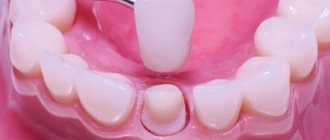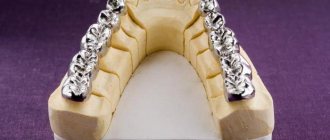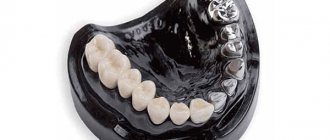What are fixed dental bridges?
This is a prosthesis that restores lost teeth. It is a structure (bridge) of three or more teeth. The bridge is installed based on the patient’s outermost natural teeth. That is, in essence, this is a bridge thrown between the supporting teeth. In this case, the supporting teeth must be prepared (ground). This design allows you to quickly recreate a missing tooth or several teeth.
We would like to point out that a more modern, functional and aesthetic method of dental restoration is implants. If possible, it is better to place an implant in place of the missing tooth. And then - cover the implant with a crown.
How many teeth can be restored with a bridge?
A bridge is indicated for partial loss of teeth. If one or two teeth are missing, three at most. To restore the loss of 4 or more teeth, other options are needed.
Could there be bridges supported by implants?
They can. Bridges are indicated for implant-supported prosthetics. An implant-supported (implant-supported) design is preferable to a bridge supported by your teeth.
For example, a patient is missing 4 teeth in a row. You can do this: install 3 implants and attach a bridge of 4 teeth to them. This will be an acceptable option in terms of price/quality ratio.
Dental bridge: general characteristics
With the help of prosthetics, a number of visual and functional dental problems are solved. The name for the installation was not chosen by chance, because the principle of the device is reminiscent of engineering structures. Artificial crowns are held on a base, and adjacent intact incisors, canines and molars act as supporting elements.
The choice of the appropriate type of construction depends not only on the financial capabilities and personal preferences of the patient, but also on his medical history. That is why a full restoration is impossible without a thorough diagnosis, medical examination and adjustment of the finished system, created from casts, to the required parameters.
Types of Dental Bridges
Modern dental clinics offer many options for restoring lost units using prosthetic bridges. They differ according to different criteria:
- by manufacturing method - solid cast, adhesive, stamped, pressed, combined;
- by material - metal, metal-ceramic, ceramic, plastic, zirconium dioxide and aluminum oxide;
- according to the method of fastening - locking, adhesive, on healthy teeth, on implants.
There is also a classification according to purpose. For example, artificial prostheses are restorative, splinting, temporary and permanent.
Manufacturing technology
The main selection criterion is the amount of time spent on creating a design according to the individual standards of a particular patient. There are 3 main groups:
- Solid cast. Ideally adjacent to hard and soft tissues, airtight. In this way it is possible to reproduce the natural shape with high precision. They are strong and durable. The disadvantages include the need to grind healthy teeth, as well as the use of high-precision casting and the high cost of production.
- Adhesive. Modeling takes place directly in the oral cavity. This is a gentle alternative to the previous method when only one element is missing. There is no need to grind the adjacent crowns; the plates are glued to them using a special cement composition.
- Stamped. An outdated option that most doctors refuse because the product weighs a lot and often leads to injury to the supports.
Material for production
The type of raw materials from which products are made determines their durability, practicality and care. Modern clinics offer many options to suit every taste and budget. Types of bridges and their features (photos are presented in the article):
- Metal. They were actively used decades ago, cast from precious metals, gold and silver. They are distinguished by high strength and affordable price. However, this type has a significant drawback: the dentition looks unattractive. Damage to the supporting elements is also possible.
- Metal-ceramic. The base consists of an alloy, which is complemented by ceramic inserts. This option is considered ideal with an optimal ratio of cost and high quality. The color is matched to the shade of the enamel.
- Ceramic. There is no all-metal cast frame. These teeth look quite natural, but do not tolerate strong mechanical stress due to their fragility. You need to be very careful when wearing it.
- Plastic. They are used primarily as temporary substitutes for permanent products while they are being manufactured in the laboratory. They are produced very quickly, do not cause allergic reactions, weigh little, look attractive, but do not last long.
- Made from zirconium dioxide. All-ceramic combined dental bridges on this basis are among the most modern. They absorb all the advantages of their predecessors: light weight, reliability, aesthetic appeal, hypoallergenicity, long service life.
- Made from aluminum oxide. They are not widespread enough because they have an exorbitant price. In terms of durability, strength, beauty and other characteristics, they have proven themselves exclusively on the positive side.
Mounting type
The structures are attached in different ways, the most common in dentistry:
- Consolidation on healthy units. The product consists of crowns with holes intended for teeth and bridges that connect them. For strength, the elements are made solid. When choosing this type, preliminary grinding and depulping will be required. Dentists are resorting to the latter procedure less and less; modern technologies make it possible in some cases to skip this stage.
- On implants. When choosing this method, intact incisors, canines and molars remain intact. They will not be ground or depulped. However, the cost of treatment increases significantly.
- Adhesive method. The bridge is not put on supports, but is attached to the rear surface using special composite compounds.
- Lock fastening. This is a removable bridge, which, if necessary, can be detached and returned to its place. Grinding of the abutment crowns is also not carried out.
Indications and contraindications for installation
The procedure is indicated when a person is missing one molar or 1-4 front incisors and canines. In this case, intact teeth should remain on the sides, which will subsequently act as supporting elements and withstand the greatest pressure when chewing food. Also, this cannot be avoided when the previous design has become unusable.
Despite all the advantages of orthopedic intervention, there is a list of cases when it is contraindicated:
- absence of more than 4 crowns;
- bruxism (involuntary grinding of the jaws, which is most often observed at night);
- malocclusion (before prosthetics you will have to undergo long-term orthodontic treatment);
- acute form of periodontitis or severe periodontal disease;
- pathological abrasion of the enamel layer;
- diseases of the skeletal system (for example, osteomyelitis);
- inflammatory processes in the oral cavity;
- poor hygiene preventing installation.
In addition, this also includes general contraindications to surgical intervention. These are problems with blood clotting, allergic reactions to drug components, manufacturing materials, chronic diseases during exacerbation, taking medications that prevent blood clots, and mental disorders.
Advantages and disadvantages of dental bridges
Advantages of bridges in prosthetic dentistry:
- There is no need to wait for the installed structure to take root. That is, there is no need for osseointegration, which can last up to six months. It turns out that the adaptation process lasts quite quickly (up to 12 hours).
- This is the most economical option for restoring rows when individual units are lost than implantation.
- Modern technologies make it possible to obtain aesthetically attractive artificial teeth with full functioning. Hidden elements (fastenings, etc.) are not visible to others, so no one will even notice the medical intervention.
- The procedure has virtually no contraindications. A bridge is also placed in cases where implantation of an implant is not possible.
- Normal diction is maintained.
Weak sides:
- It is necessary to grind down the adjacent crowns remaining in the mouth. Very often, dentists resort to depulpation (removal of the nerve, cleaning and cementing of the canals).
- The normal load on the jaw bone is not fully restored. When a person chews food, the supports are loaded; the central part is practically not involved in this. As a result, the risk of bone tissue atrophy increases.
What is fixed prosthetics?
Fixed prosthetics involves implanting an artificial root into the bone tissue where teeth are missing. Subsequently, a prosthesis is installed on the root. The patient will not be able to remove the structure on his own. There is another method of restoring the dentition - using removable structures. But it has disadvantages, so it is mainly used only if the patient is not suitable for fixed dentures.
Differences in dentures
Installation of a dental bridge: stages of the procedure
The process of manufacturing and installing the structure is simple and does not require additional actions aimed at violating the integrity of soft tissues, suturing, etc. The adaptation period is easy and painless. Despite its simplicity, the doctor and patient will have to go through several successive steps before the lost units are completely restored. On average, 3 visits to the dental office will be required.
Stage 0: sanitation of the oral cavity before the procedure
If during the initial examination the specialist suggested installing a bridge, he should carefully examine the oral cavity. One of the main conditions for prescribing treatment is the absence of carious lesions, inflammatory processes and other dental disorders.
The duration of this period depends on the condition of hard and soft tissues. If a person regularly visits the clinic for preventive purposes, it is likely that a routine cleaning will be required without applying filling material. If there are advanced diseases, they must be treated, and only then can you contact an orthopedist.
Stage 1: preparation of abutment teeth and production of a bridge.
When the dentist is sure that all units are completely healthy, a support is selected. The elements are ground, depulped, and the roots are filled.
Impressions are taken from the finished fastenings. They are sent to the dental laboratory.
While the permanent product is being manufactured, the patient will have to wear a temporary one with a plastic base. This may take 1-2 weeks depending on the workload of the institution and the complexity of the technological processes.
When there are not enough natural teeth, or they are of too poor quality, they cannot be cured and properly prepared for the procedure, implantation is indicated. Typically two anchor points are implanted.
Stage 2: installation of a fixed prosthesis
At the last visit to the dental clinic, the plastic structure is dismantled, and in its place is installed one made in the laboratory using impressions. The orthopedist checks how tightly the material adheres to the surfaces. There should be no obstruction to the closure of the jaws and no visible color differences, otherwise the artificial areas will be noticeable.
A full fitting, fitting and fixation is carried out. For greater reliability, special cement is applied.
If the client feels discomfort, prosthetics are not performed. The system is dismantled and returned to the laboratory for adjustment. If there are no unpleasant sensations, the treatment is completed.
Adaptation occurs even while wearing plastic. This means that the patient will be able to easily return to their normal lifestyle within a few hours. The doctor gives recommendations on the use and care of the product, prescribes routine examinations and provides other important information.
Veneers, crowns, inlays
When a patient goes to the dentist with minor damage to the surface of a tooth located in the smile area, the optimal solution would be to install veneers. Thin ceramic plates are fixed to the front of the tooth using dental adhesive. Such designs are almost invisible when worn thanks to a wide range of ceramic shades, allowing the doctor to select a plate whose color best matches the client’s natural tooth.
The method of installing ceramic onlays on a tooth does not imply aggressive treatment of healthy tissue, so the procedure is comfortable for the patient, and the risk of developing caries and other destructive processes under the plate is minimal. This method of restoring the aesthetics of a smile is suitable for anyone who has minor damage to their front teeth. The same recommendations apply to crowns and inlays. The only difference is that they are more often used for the restoration of chewing incisors.
Recommendations after installation
Artificial structures also need to be properly maintained. If hygiene rules are not followed, this will significantly reduce the life of the product, and the patient will again have to use the services of an orthopedist.
Dentists recommend the following measures when performing dental prosthetics with bridges:
- Daily cleaning in the morning and evening. You must use a brush and paste. After each meal, you need to rinse your mouth with clean water or mouthwash, and use floss (dental floss).
- Hard-to-reach areas and interdental spaces are cleaned using sweeping movements without pressing on the crowns.
- It is important to exclude hard nuts, seeds and other foods from your diet that can cause chips and cracks.
- During the first time after installation, you should not drink coffee and tea, red wine, or freshly squeezed juice.
- You should visit the dental clinic for preventive examinations at least once every six months and undergo professional cleaning.
All structures have a certain service life. It depends on the material used and manufacturing technique. This period varies from 5 to 15 years. Sooner or later the product will have to be replaced, otherwise it may simply break and fall out.
The device is dismantled prematurely with the following problems:
- loosening;
- broken crowns;
- chipping of small fragments, appearance of microcracks;
- inflammation of soft tissues, bleeding gums;
- washing out the cement composition on which the system rests.
Only a specialist can safely remove the prosthesis; you cannot do it yourself at home. If you follow all the rules listed above, your smile will remain dazzling for a long time, and replacement will not be needed soon.
Which fixed dentures to choose
Microprosthetics with veneers are recommended for restoration of the smile area. These are modern techniques that allow you to achieve aesthetics. In addition, they are not colored with food coloring.
In case of partial absence of teeth, implants or bridge types of prostheses are used. The best option is implantation of All on 4 or All on 6. They are characterized by a long service life and a good aesthetic effect. Bridge structures are suitable for installation directly on the upper and lower jaw.
How much does it cost to build a bridge?
The price for dental bridge crowns is determined by the cost category of the impressions, the design itself, installation and fitting services. There are the cheapest options available to most patients, but they will be significantly inferior to the more expensive ones in terms of operational and other characteristics.
On average, a budget bridge can be installed for 3 thousand rubles. Zirconium and metal-ceramic elements will cost 20 thousand or more, especially if implantation was performed.
The main factors on which the final installation cost depends
What affects the cost of orthopedic intervention:
- Material of manufacture. Plastic can be purchased several times cheaper than metal or ceramics. The last option with a zirconium dioxide frame is the most expensive.
- Application of implants. They can significantly increase the number of zeros on a check.
- Number of elements to install.
- Clinic location. Treatment in Moscow is much more expensive than in the regions.
- Pricing policy of a dental institution. This is due to market conditions, competitiveness, status and reputation of dentists.
Prosthetics allows you to restore lost teeth in a short time and without large material costs. When installing the structure, certain conditions must be met, and the patient must go through several successive stages. Unfortunately, despite the obvious advantages, bridges are not without their negative aspects. In addition, there are contraindications when it is not possible to restore the aesthetic appeal of a smile without harm to health in this way.
Advantages
- Strong fixation, there is no chance that the structure will fall out;
- For care, it does not need to be removed from the mouth; it can be cleaned like regular teeth;
- Restores both one and several missing teeth in a row;
- There are different material options;
- The classic design is cheaper than implant prosthetics;
- Can be placed on implants for prosthetics in the absence of supporting teeth.
Due to these advantages, a dental bridge is considered one of the best prosthetic options.









